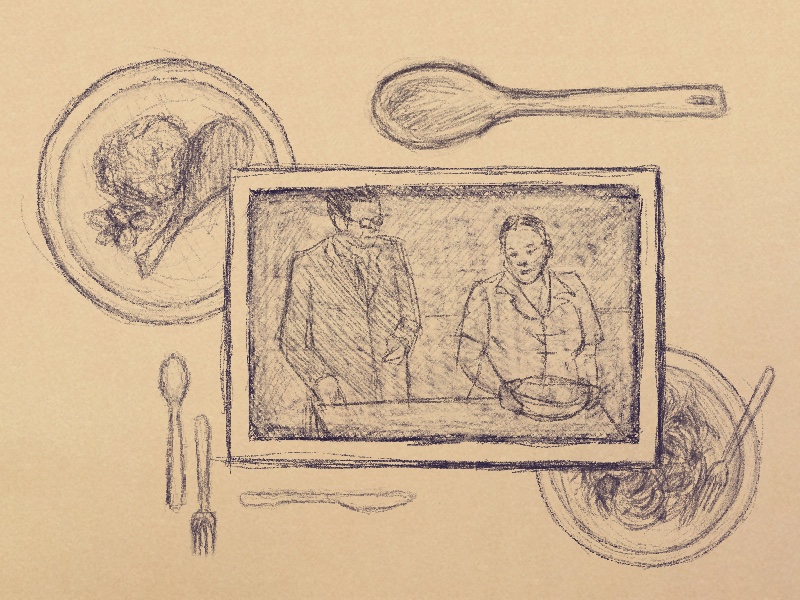By: Arlette Martinez
Simona Bondavalli is an Associate Professor and Chair of Italian at Vassar College in Poughkeepsie, NY, where she teaches Italian language and culture, contemporary literature and film, and food studies. During the Food Matters and Materialities at Carleton University, Bondavalli’s presentation “Dinner’s Ready! Or is It?: Food knowledge, Gender Roles and the Unruly Matter of Italian Cuisine in 1970s Cooking Game Shows” explored the role of early Italian television in redefining Italian national identity.

Credits: Illustration by Kit Chokly.
Bondavalli talked about how after World War II, Italy became a republic and started to focus on rebranding itself. After two decades of fascism, there was a conscious effort to create a national identity as a democratic country and redefine Italy moving forward. Bondavalli became interested in this period and decided to focus on television as an emerging and popular medium of the time. She found that much of the television content of that era seemed to share a common purpose: rebranding and rebuilding Italian identity after the war.
“I think food played an important role in it. At the same time, there was an increase in the production of documentaries during that period. There seemed to be an overall motivation to make Italians aware of Italy and of what other fellow Italians do.”
Like many parts of the world, prior to the mid-20th century, Italy struggled with inequality that led to hunger for many for centuries. The post-war era meant major social restructuring and greater food access for more people. According to Bondavalli, Italian public television focused on “convincing Italians they were finally free from hunger”.
By the 1970s, things were changing again in Italy. The Italian women’s movement saw liberation from the kitchen as freedom from other domestic roles. As a direct response, the fairly conservative government sought to reinvent Italian cuisine through trivia games and cooking contests on Italian public television (RAI).
Bondavalli’s research looked at two cooking competition shows, Colazione allo Studio 7 (Breakfast at Studio 7, RAI 1971-73) and its successor, A Tavola alle Sette (Dinner’s ready at seven, RAI 1974). RAI created these shows for an audience increasingly removed from food sources and concerned with the consequences of overeating. As Bondavalli explains, “A Tavola educated, entertained, and comforted viewers with a surrogate of home cooking, and the ritual of sitting down to dinner.” She added that this show’s launch “coincided with the publication of scholarly books on gastronomy, and with cuisine and cooking entering the realm of high culture.”
A Tavola’s two hosts were respected gastronome Luigi Veronelli and beloved character actress Ave Ninchi. Bondavalli argues that “the playful onscreen banter between the co-hosts and their interactions with their guests and the audience revealed underlying gendered tensions between gastronomic expertise and home cooking as a practice; between contemporary women’s lifestyles and traditional expectations; and between cooking as a hobby and as a duty”. Veronelli’s role was the expert, while Ninchi’s was a surrogate mother, a home cook, with a sense of humour. But Veronelli constantly made jokes at Ninchi’s expense, mostly about her weight, skill, and gender.
Bondavalli clarifies that A Tavola did not specifically address gender as a topic, nor did it try to speak to women directly. Instead, the jokes and banter between hosts were a way to convey messages to viewers about women’s bodies, proper food, and who could be a cooking expert. According to Bondavalli, it’s unclear how successfully these shows shaped contemporary Italian identity regarding gender roles and food. In her view, these shows reflected how complex Italian society’s relationship with food was and continues to be. “From the hosts’ interaction with the audience and guests, it becomes clear that people cook in different ways.”
I asked Bondavalli what elements from these earlier shows are a part of modern Italian television, and she responded, “The way things are joked about is different. I haven’t done enough research to describe how it’s changed exactly. I can say that contemporary Italian TV is inundated with cooking shows. American cooking competition shows, like Master Chef, now have an Italian version. But again, the chefs and the authorities on those shows tend to be male.”
Bondavalli explained that the expectation remains that women cook to care for their family as a duty, not for the joy of doing it. She argues that some Italian television shows on RAI still try to educate the viewer and regulate cooking by using gastronomy and tradition on state television to bring Italians together and say, “you’re supposed to do this.”
Bondavalli’s analysis of RAI programming in the 1970s reveals the state media’s role in shaping post-war Italian identity as intimately tied with Italian cuisine while promoting traditional gender roles by modeling citizen behaviour on television. While neither of these threads is unique to Italy, an historical analysis of them in this instance uncovers how state media attempted to shape the intimate space of its citizens’ kitchens by prescribing who should cook and what should be on the menu.